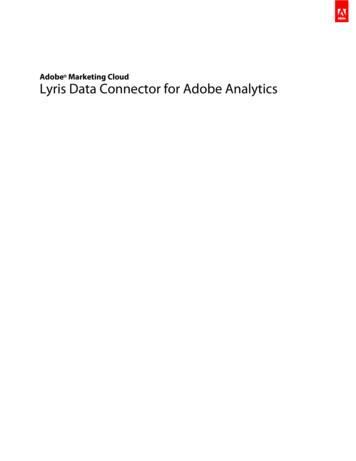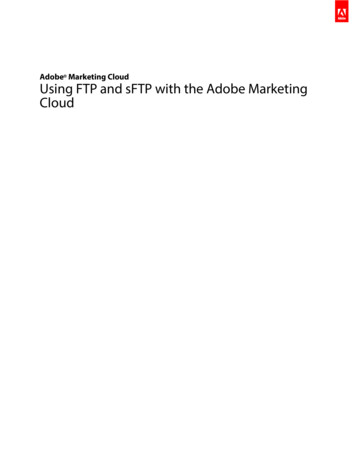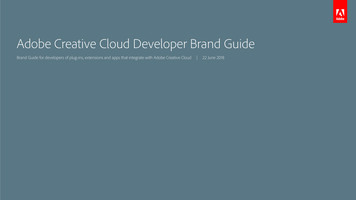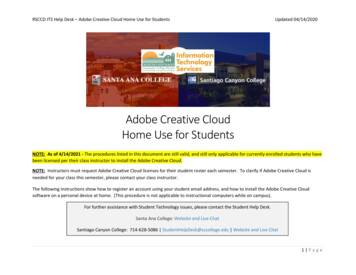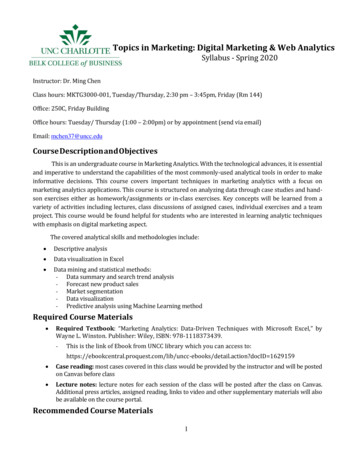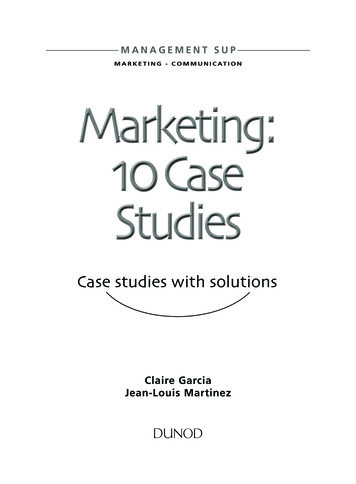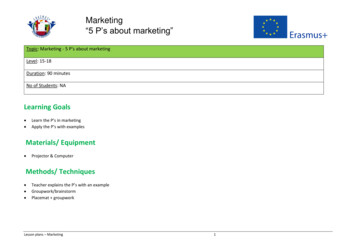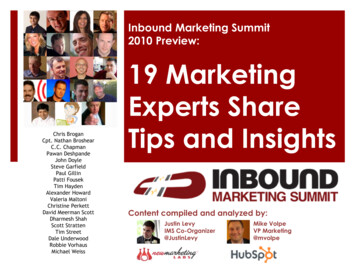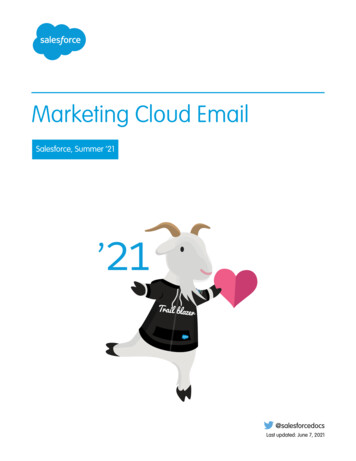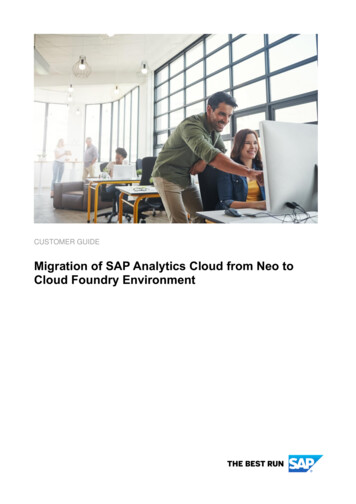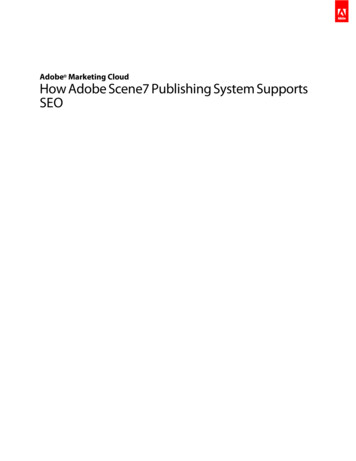
Transcription
Adobe Marketing CloudHow Adobe Scene7 Publishing System SupportsSEO
ContentsContact and Legal Information.3Introduction.4Indexing of images by search engines.4Maintaining the name of the image.6Scene7 Viewer SEO Best Practices.10Last updated 2/9/2015How Adobe Scene7 Publishing System SupportsSEO
Contact and Legal Information3Contact and Legal InformationInformation to help you contact Adobe and to understand the legal issues concerning your use of this product and documentation.Help & Technical SupportThe Adobe Marketing Cloud Customer Care team is here to assist you and provides a number of mechanisms by which theycan be engaged: Check the Marketing Cloud help pages for advice, tips, and FAQs Ask us a quick question on Twitter @AdobeMktgCare Log an incident in our customer portal Contact the Customer Care team directly Check availability and status of Marketing Cloud SolutionsService, Capability & BillingDependent on your solution configuration, some options described in this documentation might not be available to you. Aseach account is unique, please refer to your contract for pricing, due dates, terms, and conditions. If you would like to add toor otherwise change your service level, or if you have questions regarding your current service, please contact your AccountManager.FeedbackWe welcome any suggestions or feedback regarding this solution. Enhancement ideas and suggestions for the Analytics suitecan be added to our Customer Idea Exchange.Legal 2015, AdobeAll rights reserved.Published by Adobe Systems Inc.Terms of Use Privacy CenterA trademark symbol ( , , etc.) denotes an Adobe trademark.All third-party trademarks are the property of their respective owners. Updated Information/Additional Third Party CodeInformation available at http://www.adobe.com/go/thirdparty.
Introduction4IntroductionA common way to use SPS (Scene7 Publishing System) is to manage the product imagery on e-commerce sites. Website managersare constantly trying to improve their ranking in search engine results.Search engines are still a primary traffic generator for most e-commerce sites. They even complement other methods of guidingusers to a website, such as banner ads and third-party advertising.Search engines today enable search for websites and images. SPS supports efforts to make images more search-engine friendlyso that more traffic is driven to the Scene7 user's website. This document gives you the background and implementationrecommendations to make that happen.Additional links to SEO information:Rank in Image Searches and Get Valuable, Untapped TrafficGoogle Image OptimizationIndexing of images by search enginesSearch engines index images within their context. The context that describes the image consists of numerous values. Some ofthese values include the following: Image name. Alt tag. Folder of the image on a web server. Surrounding text/web site topic, and so on. Image size and quality. Keywords used to link the image.The importance of these values differs from (image) search engine to (image) search engine. However, SPS helps with one ofthe most important values: the image name.Name your images with relevant keywords included. And, higher resolution images are more important than lower resolutionimages.The following code example shows how images from your SPS account are embedded into your site:In HTML 5, the img tag can carry the following attributes:AttributeSpecified valueDescriptionaltTextA short description of the image.
Introduction5AttributeSpecified valueDescriptionwidthPercent of pixelsWidth of an image.heightPercent of pixelsHeight of an image.srcURLURL path to the image.ismapURLURL path to the image as a server-side image map.usemapURLURL path to the image as a client-side image map. See map and area tags tounderstand how it works.The following standard attributes are also relevant for images: class contenteditable contextmenu dir draggable id irrelevant lang (See also Using templates with the rule set example) ref registrationmark tabindex template titleMaintaining the alt attributeThe alt attribute is of high importance to search engines. Configure the CMS/e-Commerce system in a way that a properdescription of the image is contained in the alt attribute.The alt tag is visible to the user, as browsers reveal it during loading time. Another strong use of the alt tag is for obstacle-freeweb design. That is, browser extensions that support disabled users to browser extensions using the alt tag to describe thecontent to the user.The CMS/e-Commerce system maintains the alt attribute of images to describe the image or product. Search engine-friendlyimages are important. However, the use of additional keywords in the alt attribute is limited.
Introduction6Maintaining the name of the imageA well-chosen name for an image can deliver a higher ranking for that image.A typical Scene7 image call looks like the following any/imageID?parametersHowever, in terms of search engine friendliness, there are two major disadvantages: The imageID is simply an ID for most Scene7 users. For example, the product ID or SKU. The question mark introduces the parameters. The search engine interprets this as dynamic content.An ideal URL path looks like the r2/spoken image name.jpgThe following steps explain how to leverage Scene7 to create optimized image URLs.Changing the Scene7 image host server nameFirst, as an SPS customer you can use the platform when your user credentials are issued to you. You get a Scene7 server–suchas S7xx.scene7.com–as your image host.If you want to use a server name that includes your domain–such as images.mycompany.com–as Scene7 Technical Supportto initiate the required steps. Scene7 configures the appropriate steps. When this configuration is complete, you are given allthe information necessary to pass to your DNS provider, to enter a CNAME that maps the server name of your domain to Scene7servers.Note: The server name is designed exclusively for Scene7 content.Your image URLs will look similar to the following nyname/imageID?parametersUsing https with a custom Scene7 image host server nameEven less SEO relevant this is an often asked question.Scene7 provides https support for the scene7.com domain-based servers. However, this support is different for domainswithin your own company.To support https traffic from your customer server you can contact Scene7 Technical Support. They can provide appropriateguidance on how to enable such a domain. Additional custom domains that are supported by way of https are charged.The best practice is to use the custom domain in https context and to use the Scene7 domain in http context.Helping SPS understand other image URLsSecond, use the Scene7 rule sets. Rule sets are similar to the URL-rewrite method that is widely used in the context of searchengine friendliness of websites.You can find details of rule sets in the Image Serving API reference.The following example of a rule set assumes that images are called using a preset:
ompanyname/imageID? presetname A rule set is an XML file you can upload into your SPS. You can make the XML file the rule set in SPS by clicking Setup Application Setup Image Server Rule Set Definition File Path.A rule set exampleThe following XML code shows a complete rule set example: !DOCTYPE ruleset SYSTEM "RuleSet.dtd" ruleset rule Name "Removepart of the ID before the minus" expression (.*)/(.*)-(.*)\.jpg /expression substitution 3?\ 1\ /substitution /rule /ruleset The regular expression in the rule is used to identify the URLs that are rewritten. Every URL that ends with .jpg and matchingthe rest of the expression, fires off the rule. The rule rearranges the incoming URL.For example, the rule translates /presetname/SomeText-ImageID.jpg into imageID? presetName .Scene7 Image Server ignores SomeText and the minus character (-) acts as a delimiter. For this rule to work, the image IDcannot contain a minus in the ID.Now the Scene7 account understands both variations of the imageID? presetname resetname/any text-ImageID.jpgThe second URL simply looks like a static file on a web server's file system. It has no dynamic nature by parameters. As thispoint, you can start calling Scene7 images using this new URL structure.This rule set example delivers the following results: You can use descriptive text in the filename of the image. You can differentiate filenames by such things as language. You can use additional keywords in the image name, such as a product category. Enables traditional Scene7 protocol so that migration is easy. An exception is when a URl ends with .jpg.
Introduction8Using the rule set exampleThe rule set example earlier works fine with any image preset name. To provide the search engine with high-quality images, usea preset for large images like on the product detail page.The previously used website called this image with an image preset:.com site(English) IMG src 00S10? gr370 Alt "jacket" .de site(German) IMG src 00S10? gr370 Alt "Jacke" .fr site(French) IMG src 00S10? gr370 " Alt "Veste" New websites use the information of the Alt attribute along with any additional information that the CMS/eCommerce systemcan deliver. This enriches the description of the image when the search engine performs an index crawl.The same image is used and indexed with three different image names as each languages requires its own keywords.com site(English) IMGsrc Sportswear-Fashion-Jacket-41612800S10.jpg"Alt "jacket"
Introduction.de site(German)9 IMGsrc Sportbekleidung-Mode-Jacke-41612800S10.jpg"Alt "jacket" .fr site(French) IMGsrc Sportswear-Fashion-Vente-41612800S10.jpg"Alt "jacket" Using templates with the rule set exampleThe template functionality of SPS is powerful for auto generating images. For example, overlaying these images. It is often usedwith parameters in the template call. This use contradicts the search engine friendliness mentioned earlier. Templating is aconversation-driving topic and therefore important for traffic already on your site. It is typically seen as more valuable than thepotential of traffic from a search engine.The following are solutions for this. The sample rule set explained above.Making templates and the typical parameters part of the image preset. (&template) Different languages for the image nameThe example above with different languages also requires maintaining the lang attribute of the img tag. SPS Reporting and Rule SetsThe use of image URLs not according to the standard syntax for image presets results in a failure of correct image contentreporting. See Setup Application Setup Bandwidth & Storage Image Content.SPS lets you combine the use of search-engine-friendly URLs and preset-based image content reporting under the followingconditions: The preset name is used as the first folder. For example, is/image/company/presetname/. The URL ends on an image suffix such as .jpg or .png. For example, ./company/preset/.jpg.Asset-based reporting is correct when the asset is separated with two hyphens from the inserted text and the URL ends on animage suffix as in ./SomeText--ImageID.jpgSample rule to avoid indexing using an HTTP header attributeSome customers are required to limit the indexing of images by search engines to a dedicated format while other images, suchas thumbnails, are not indexed. Because SPS is a SaaS solution certain web techniques, such as using robots.txt to define this,are not usable.Another approach is to influence the http-header of the image response. You can achieve this with the following rule example: rule OnMatch "break" Name "No Index" expression thumbs/(.*)--(.*)\.jpg /expression substitution 2?\ thumbs\ /substitution header Name "X-Robots-Tag" noindex /header /rule This rule example adds an http-header to each image that is called from is/image/company/thumbs/anytext--imageID.jpg.See Robots meta tag and X-Robots-Tag HTTP header specifications.
Introduction10Adding a link attribute to the HTTP headerAdding a link attribute to the HTTP header can help increase search engine friendliness. The canonical link tells Google thatthe image is connected to a specific page. It is useful when you do an image search in Google.If the HTTP header is assembled dynamically and takes over information from the original URL, it becomes tricky for the staticHTTP header tags discussed previously. Rather than transforming the URL directly you can define a variable in the substitutionand use it in the header tag. You cannot use 1 or similar syntax in the header tag.Rule example: rule RequestType "is" OnMatch "break" expression (.*?)/(.*?)--(.*)\.jpg /expression substitution 3?\ 1\ &\ link 3?\ 1\ /substitution headerName "Link" http://images.customer.com/is/image/customer/ link rel "canonical" /header /rule This rule links back such image com/is/image/customer/assetID? preset The benefit is that even when you use different SEO text, such as text in different languages, the SEO benefit is collected underthe canonical URL. However, this method is not supported for Image Search yet.See Use Canonical URLs.Scene7 Viewer SEO Best PracticesSupply a default image placeholder and alt text for images.To ensure that Scene7 viewers do not detract from your image search results, always supply a default image placeholder andalt text for that image. This image then gets replaced when the viewer loads.Do not put just the viewer on your page. If you do, it becomes invisible to search engines because it does not initialize until thepage loads; it requires JavaScript. For SEO, construct your pages so that they are SEO-friendly without any JavaScript enabled.If you look at Verizon Wireless' PDP, especially if you disable JavaScript, y-s-5/, you will see an image with an alt tag load first:After the viewer loads, the image is hidden. However, SEO sees this image and its tag and uses it for indexing. This page evenhas fallback content for video as well, along with compliant Schema.org metadata tags. No one encounters the video unless theyhave disabled JavaScript. But, it is perfect for search engines:
IntroductionSo, why does SPS not insert all of this page coding for you? Remember that SPS does not generate your HTML and it has noaccess to your data. SPS does not know the alt tag of the image or the metadata (title/description) of the video.11
Search engines are still a primary traffic generator for most e-commerce sites. They even complement other methods of guiding users to a website, such as banner ads and third-party advertising. Search engines today enable search for websites and images. SPS supports efforts to make images more search-engine friendly
